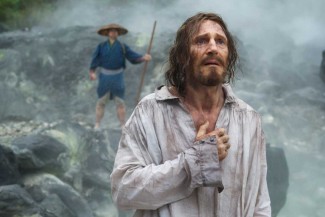
Martin Scorsese’s new film, “Silence,” defies simple description. The movie, which tells the story of 17th century Portuguese Jesuit missionaries, explores many lofty themes. Certainly faith and doubt, as well as good and evil. There are also intriguing questions as to whether a belief system can truly be universal, or if a religion will always serve specific people from specific places and cultural backgrounds.
Jesuit Fr. James Martin, who served as a consultant on the film, likened “Silence” to “living inside a prayer,” and just as prayer often leaves one questioning whether they heard or were heard by God, this movie offers no easy answers.
The film opens with two young Jesuit priests — Fr. Sebastião Rodrigues (Andrew Garfield) and Fr. Francisco Garrpe (Adam Driver) — learning that their mentor, Fr. Cristóvão Ferreira (Liam Neeson), has committed apostasy, publicly denying the “Christian God,” while serving as a missionary in Japan. Incredulous, the two young Jesuits resolve to travel to Japan to save their teacher and engage in their own missionary work.
The extraordinarily faithful Catholics they encounter in Japan have been driven underground by the Tokugawa shogunate, a military government whose leaders have banned Christianity, forcing captured practitioners to denounce their faith by stepping on a fumi-e, an image of Christ or the Virgin Mary. Those who refuse are tortured and killed using methods that set new standards for brutality.
RELATED: “Silence” and What Constitutes Apostasy
The agony that awaits Fr. Rodrigues is more psychologically than physically vicious. His captors torture Japanese Catholics within eye and earshot of the priest’s prison cell. These Catholics have already stepped on the fumi-e, Fr. Rodrigues is told. But unless he does, too, their torture and eventual death will continue. Father Rodrigues sees heroism in the possibility that he might be martyred, but as he is told by the Tokugawa shogunate inquisitor (Issey Ogata), “The price for your glory is their suffering.”
The priest’s choice might not seem to be a dilemma to those who view the fumi-e as little more than an outward symbol — a line of argument used by both members of the Japanese government and Fr. Ferreira, whose rumored apostasy is true. While empathizing with Fr. Rodrigues’ anguish, those with strict views on adherence to Catholic teaching may also struggle to see a justification for stepping on the fumi-e.
But for those who, like Pope Francis, believe that “in life, shades of gray predominate,” that right vs. wrong isn’t always an all-or-nothing matter, Fr. Rodrigues’ path is less clear.
This theme of uncertainty dominates the film. Is God present in silence? With us in our suffering? Are there ever moral grounds to engage in an ostensibly immoral act? How do we come to true forgiveness for ourselves and for others? And what does it mean to be faithful in near-impossible circumstances?
“Silence’s” lack of resolution will surely frustrate some moviegoers. Bishop Robert Barron, for example, wrote, “My worry is that all of the stress on complexity and multivalence and ambiguity is in service of the cultural elite today, which is not that different from the Japanese cultural elite depicted in the film. What I mean is that the secular establishment always prefers Christians who are vacillating, unsure, divided, and altogether eager to privatize their religion.”
RELATED: The Letters: Mother Teresa as Saint and Servant of God
While that may be the case, complexity and doubt — evinced even in the life of a real-life saint like Mother Teresa — strike me as indicative of an honest spirituality: deep, mature, and at times painful.
It is to Scorsese’s great credit that his film offers no solutions to questions that can only be answered with faith. Never one to present either heroes or villains as uncomplicated creatures, the director even humanizes the Tokugawa shogunate, allowing them in one scene to articulate their fears of Christianity. While there is, of course, no way to defend the savagery of their actions, their concerns about missionary efforts are not entirely without merit.
“Silence” transcends straightforward questions, answers, and explanations. In so boldly and unapologetically embracing this harrowing uncertainty, the film manages to be a work of profound faith.